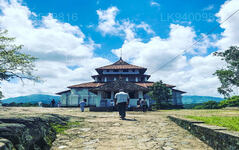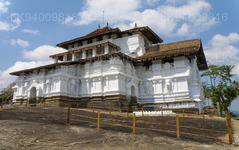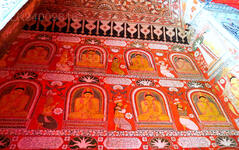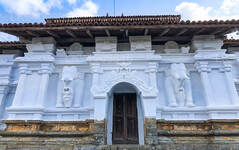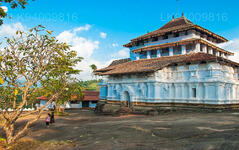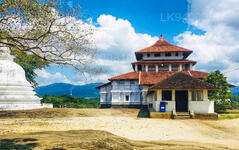
Ciudad de Kandy
Kandy, una pintoresca ciudad en el centro de Sri Lanka, es famosa por su rico patrimonio cultural, sus vibrantes festivales y su belleza paisajística. Enclavada entre exuberantes colinas, alberga el Templo de la Reliquia del Diente, declarado Patrimonio de la Humanidad por la UNESCO, y ofrece una cautivadora combinación de historia y esplendor natural.
Lankathilaka Viharaya
Lankathilaka Viharaya in Sri Lanka: The Great Temple of the Kings
Lankatilaka is Buddhist temple of the 14th century in the Hiyarapitiya village, from the Udu Nuwara area of Kandy district in Sri Lanka. This historical temple was built by the Gampola king, King Buwanekabahu the fourth (1341 – 1351AD), in 1344 AD. Gampola was a stronghold on the banks of Mahaveli River.
Lankathilaka Viharaya in Sri Lanka: Architectural Facts
- The temple was designed by the South Indian architect Sthapati Rayar.
- According to the opinions of researchers; the temple combines the design elements of the Polonnaruwa era architecture with that of Dravidian (India) and Indo-Chinese design. At the time of construction the temple was a four storied edifice of eighty feet, built on uneven bedrock using a granite based foundation.
- The temple structure is such that it radiates from the centre in the four cardinal directions, like a cross. Only then ground floor and part of the first floor of the original temple can be seen today, though the temple appears to have three stories from the outside.
- The thick outer walls of the Temple have beautifully sculpted arches and various sculptures making it a unique design of the 14th century.
Lankathilaka Viharaya in Sri Lanka: Sights when entering the Temple
- There are two directions of approach to the temple. One of them has abodes for Buddhist monks at the base of the rock.
- The premises also have many sights such as the huge rice storage bins, known as ‘Atuwa’ by the locals. The stairs begin in the premises of the abodes.
- The other method of approach is from the west of the temple.
- With two ways of approach come two different flights of stairs. One is the original flight built in the 14th century, while the other is more recent; built around 1913. The stairs are cut into the living rock of Pahangalla and provide a climber with beautiful views of the surrounding countryside.
- At the top of the old flight of stairs, the premises of the temple can be entered through a primitive stone door arch, created with three long pieces of rock affixed together.
Lankathilaka Viharaya in Sri Lanka: The Temple
The temple premises have three sectors; the actual temple building, the Dagoba or stupa and finally the Bo tree.
The temple like the flights of stairs has two entrances, leading to two different and disconnected sections in the same building. The main and most important sector is the eastern section, the Buddha Image House. The other is on the west, the the Temples of the Gods.
The Buddha Image House
- The Buddha Image House which is approached from the eastern entrance, right in front of the eastern flight of stairs, and has a Moonstone adorning the ground before the entrance.
- Def. Moonstone: A semi-circular piece of stone which stands at the foot of a flight of steps in most historical Buddhist buildings.
- Two balustrades carved with the Gajasinha or elephant headed lion hybrid design flank the short flight of stairs leading to the entrance archway of the temple.
- The outer archway has a Makara Torana or dragon figure with some unique characteristics that differentiate it from the usual Makara Toranas.
- On the wide inside side walls of the archway display wonderfully preserved paintings of lions. A pair of guardian statues stands close to the wooden door, which has several panels painted with creepers and various designs.
- The inside of the Buddha Image House is an art masterpiece in its entirety with the walls and ceiling completely covered in beautiful paintings dating back to the construction of the temple.
- The pigments used are mostly red, white, yellow and black; with red being the dominant colour possibly because ochre was a pigment that could last the ravages of time.
- The paintings depict the lives of the 24 former Buddhas on the walls, while the ceiling has an abstract flower design.
- The centrepiece of the Buddha Image House is a beautiful golden toned seated Buddha statue. Above the statue is another Makara Torana with sculptures of angels watching over.
Lankathilaka Viharaya in Sri Lanka: Rock Inscriptions
There are inscriptions cut into the rock surface on the temple premises. The inscriptions are both in Sinhala and Tamil, stating that the land was gifted to the Temple by the kings and describing other facilities offered to the temple.
The Lankatilaka Temple is a beautiful cultural heritage of Sri Lanka that has to be visited on a holiday to the country. This temple along with the Embekke temple remains one of the most architecturally advanced structures of the Gampola Kingdom era.
Acerca del distrito de Kandy
El distrito de Kandy está situado en la provincia central de Sri Lanka. Kandy, uno de los siete sitios declarados Patrimonio de la Humanidad en Sri Lanka, fue en el siglo XVI el hogar de los antiguos reyes kandyanos y una fuente de toda la música, las artes, la artesanía y la cultura del país. A unos 129 km de Colombo, Kandy está enclavada en un terreno montañoso y todas las miradas se dirigen al centro de la ciudad, donde el lago Kandy forma un elemento encantador. Kandy conserva un gran significado religioso para Sri Lanka, ya que en esta encantadora ciudad se encuentra el Dalada Maligawa o "Templo del Diente", en cuyo interior se encuentra bien custodiada la reliquia sagrada del diente de Buda.
El Real Jardín Botánico de Peradeniya se encuentra a unos 5 km al oeste del centro de la ciudad y recibe la visita de 1,2 millones de personas al año. Es el jardín botánico más grande de la isla. El Udawatta Kele (Bosque Udawatta) es un santuario protegido situado en el corazón de la ciudad, justo al norte del Templo del Diente.
Kandy es una ciudad de mayoría cingalesa; existen importantes comunidades pertenecientes a otros grupos étnicos, como moros y tamiles. Kandy ocupa el segundo lugar, después de Colombo, como centro de la economía de Sri Lanka. Muchas grandes empresas tienen grandes sucursales en Kandy, y numerosas industrias, como la textil, la del mueble, la informática y la joyería, se encuentran aquí. Numerosos centros de investigación agrícola se encuentran en la ciudad.
Y fuente de toda la música, las artes, la artesanía y la cultura del país. A unos 129 km de Colombo, Kandy se encuentra enclavada en un terreno montañoso y todas las miradas se dirigen al centro de la ciudad, donde el lago Kandy forma un encantador paisaje. Kandy conserva una gran importancia religiosa para Sri Lanka, ya que en esta encantadora ciudad se encuentra el Dalada Maligawa o Templo del Diente, donde se custodia la reliquia sagrada del diente de Buda.
Acerca de la Provincia Central
La Provincia Central de Sri Lanka se compone principalmente de terreno montañoso. Tiene una superficie de 5.674 km² y una población de 2.421.148 habitantes. Algunas de sus ciudades principales son Kandy, Gampola (24.730), Nuwara Eliya y Bandarawela. La población es una mezcla de cingaleses, tamiles y moros.
Tanto Kandy, la capital de la montaña, como Nuwara Eliya se encuentran en la Provincia Central, al igual que Sri Pada. La provincia produce gran parte del famoso té de Ceilán, plantado por los británicos en la década de 1860 tras una devastadora enfermedad que destruyó todas las plantaciones de café de la provincia. La Provincia Central atrae a numerosos turistas, con pueblos en las colinas como Kandy, Gampola, Hatton y Nuwara Eliya. El Templo del Diente o Dalada Maligawa es el principal lugar sagrado de la provincia Central.
Tanto Kandy, la capital de la montaña, como Nuwara Eliya se encuentran en la Provincia Central, al igual que Sri Pada. La provincia produce gran parte del famoso té de Ceilán, plantado por los británicos en la década de 1860 tras una devastadora enfermedad que destruyó todas las plantaciones de café de la provincia. La Provincia Central atrae a numerosos turistas, con pueblos en las colinas como Kandy, Gampola, Hatton y Nuwara Eliya. El Templo del Diente o Dalada Maligawa es el principal lugar sagrado de la provincia Central.

